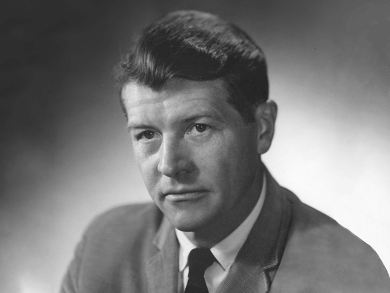Early Life and Education
Christian Boehmer Anfinsen was born on March 26, 1916, in Monessen, PA, USA, as the son of Norwegian immigrants. He received his B.S. from Swarthmore College, PA, USA, in 1937. Anfinsen went on to study organic chemistry at the University of Pennsylvania in Philadelphia, where he received his M.S. in 1939.
That same year, Anfinsen received a fellowship from the American-Scandinavian Foundation that allowed him to study the structure of enzymes at the Carlsberg Laboratory in Copenhagen, Denmark. There, he was mentored by Kaj Ulrik Linderstrøm-Lang, known for defining the primary, secondary, tertiary, and quaternary structure of proteins. The spread of World War II prompted him to return home to the United States in 1940.
After his return to the US, Anfinsen studied biological chemistry at Harvard Medical School, Boston, MA, USA, and finished his Ph.D. there in 1943 under the supervision of Albert Baird Hastings. He remained at Harvard until 1950 and worked on malaria research, proteolytic enzymes, and radioactive labeling. This time included a stay at the Medical Nobel Institute in Stockholm, Sweden, from 1947 to 1948, where Anfinsen started to work on enzyme purification and characterization.
Career at the NIH and Focus on Ribonuclease
In 1950, Christian B. Anfinsen joined the National Institutes of Health (NIH) in Bethesda, MD, USA, as Chief of the Laboratory of Cellular Physiology and Metabolism. It was here that Anfinsen’s interests turned to ribonuclease (RNAse). The lab could secure a large supply of bovine pancreatic RNAse, a byproduct of insulin extraction, from a meat processing company. Anfinsen worked on the determination of the enzyme’s structure, but Stanford Moore and William Stein at Rockefeller University, New York, USA, won the race: They published the first amino acid sequence of an enzyme, RNAse, in 1960.
Undeterred, Anfinsen turned to a more general question, inspired by the breaking and reformation of disulfide bonds in RNAse. He had observed the return of the enzyme’s catalytic activity after its disulfide bonds had been cleaved; thus, an unfolded protein in solution could refold into its active form without external influence. This phenomenon led him to propose what was later called “Anfinsen’s dogma” or thermodynamic hypothesis: A protein’s native conformation under physiological conditions is determined solely by its amino acid sequence. This notion was at first heavily challenged by the scientific community, but later became a central and accepted part of biochemistry and biotechnology.
Legacy and Death
For this breakthrough insight “concerning the connection between the amino acid sequence and the biologically active conformation”, Anfinsen was awarded the Nobel Prize in Chemistry 1972, shared with Stanford Moore and William Stein for their work on the chemical structure of ribonuclease. Christian B. Anfinsen died on May 14, 1995, in Randallstown, MD, USA.
Christian B. Anfinsen is the answer to Guess the Chemist (51) and to Guess the Chemist (159)
Sources
- The Christian B. Anfinsen Papers: Biographical Information, U.S. National Library of Medicine, Rockville Pike, MD, USA.
- Alan N. Schlechter, Christian B. Anfinsen: Biographical Memoir, National Academy of Sciences, Washington, DC, USA, 2015.
- Evangelos N. Moudrianakis, Obituary: Christian Anfinsen, The Independent, 24 May 1995.
Selected Publications
- Principles that Govern the Folding of Protein Chains,
C. B. Anfinsen,
Science 1973, 181, 223–230.
DOI: 10.1126/science.181.4096.223 - Selective enzyme purification by affinity chromatography.,
P. Cuatrecasas, M. Wilchek, C. B. Anfinsen,
Proc. Natl. Acad. Sci. USA 1968, 61, 636–643.
DOI: 10.1073/pnas.61.2.636 - Studies on the Reduction and Re-formation of Protein Disulfide Bonds,
C. B. Anfinsen, E. Haber,
J. Biol. Chem. 1961, 236, 1361–1363. - The Kinetics of Formation of Native Ribonuclease During Oxidation of the Reduced Polypeptide Chain,
C. B. Anfinsen, E. Haber, M. Sela, F. H. White,
Proc. Natl. Acad. Sci. USA 1961, 47, 1309–1314.
DOI: 10.1073/pnas.47.9.1309 - Peptide separation by two-dimensional chromatography and electrophoresis,
A. M. Katz, W. J. Dreyer, C. B. Anfinsen,
J. Biol. Chem. 1959, 234, 2897–2900. - The molecular basis of evolution,
Christian B. Anfinsen,
John Wiley & Sons, New York, 1959. - Reductive Cleavage of Disulfide Bridges in Ribonuclease,
M. Sela, F. H. White, C. B. Anfinsen,
Science 1957, 125, 691–692.
DOI: 10.1126/science.125.3250.691
Also of Interest
- 50th Guess the Chemist,
ChemistryViews Mag. 2016.
DOI: 10.1002/chemv.201600009



